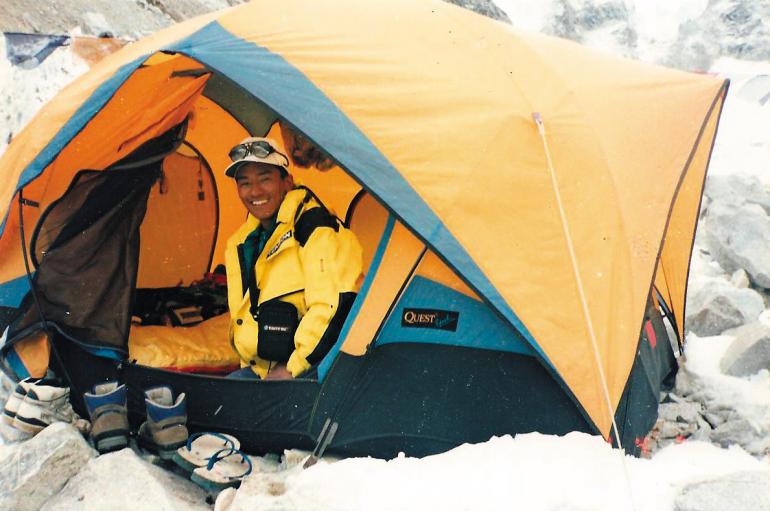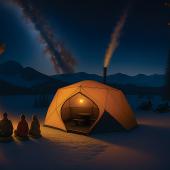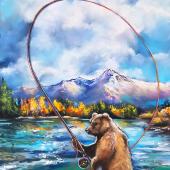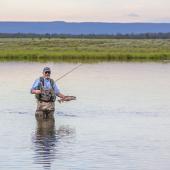Finding Nima
A sherpa's story of Mount Everest.
During a trekking expedition to the Nepal’s Anapurna region in 1999, some local children took an interest in my guidebook, the introduction of which had been penned by legendary climber Sir Edmund Hillary.
One of the children recognized the name. Pointing to it, he said, “Second man on Everest!” Did the boy know a secret no one else knew? Because both Hillary and Tenzing Norgay, his Sherpa co-summiter, have kept publicly mum on the subject, preferring to say that whoever’s bootprint was first on the top of the world is of little consequence. But try telling that to a child.
The Sherpa in the Italian Restaurant
Seven years on, I’m once again surrounded by Nepalis, but this time I’m in Sonoma, California, which for some reason has attracted 30 or so Nepalis of the Sherpa ethnic group, who hail from the Solu-Khumbu region near Mount Everest. Many of these Sherpas have worked as porters or guides on trekking and climbing expeditions; now they work as bussers and waiters in restaurants.
One of them stands out. He possesses a certain sophistication that commands respect. He has a laundry list of famous people he considers friends: Ed Viesteurs, David Breashears, Conrad Anker, Scott Fischer, Anatoli Boukreev, Alex Lowe. And he’s spent a lot of time in Bozeman in between expeditions.
I needed to ask: What’s a guy who’s worked on 13 Everest expeditions doing managing an Italian restaurant at 45 feet above sea level?
“A lot of people ask, ‘Oh, you do this, you do this, how come you’re interested in this kind of job here?'" He shrugs. “Of course. We’ve been raised up in this business a long time.”
Nima Sherpa (many from the Sherpa ethnic group use “Sherpa” as a surname, although they are not necessarily related) started working in restaurants along the Everest trekking circuit as a teenager. As his strength and skills increased, he became a trekking porter, then a guide, and eventually started working on climbing expeditions, assisting climbers as high as the 27,600 foot Camp IV.
What Sherpas Really Do
Barrel Mountaineering’s Chris Naumann first encountered Nima during the 1994 Sagarmartha Environmental Expedition, which was organized to clean up garbage left behind by climbers and trekkers. Nima was a Camp II cook at the time. “If they all get sick, we’re not going anywhere,” Naumann says, pointing out Nima’s attentiveness to climbers’ dietary needs. “It doesn’t take a whole lot to go wrong to really jeopardize a trip like that.”
Naumann explains that Sherpas do more than just the heavy lifting on expeditions, and they don’t always get the credit they deserve. “Their overall stamina and lung capacity to just move uphill is superior to most Western climbers',” Naumann says, adding that a certain positive spirit complements their physical attributes. “They are so accepting and nonpresumptive, it makes working with them a joy.”
Along with carrying staggering loads, Sherpas set fixed ropes, set up camps, cook, and attend to climbers’ needs. More recently they’ve become skilled in crevasse rescue, first aid, and detecting avalanche danger, and they are in complete control of setting up the system of ladders that leads through the dangerous Khumbu icefall. “The only Western involvement is handing cash over,” Naumann says.
Nima is blunt about Sherpas’ involvement in the expeditions: "If there's not Sherpa helping in Nepal, all these foreigners coming on expeditions in Nepal, they're just going to Base Camp and just coming back, that's all."
Nima’s command of English combined with personal, logistical, and organizational skills eventually landed him the coveted role of base camp sirdar, which meant he was in charge of hiring and managing the entire crew of Sherpas.
After the Fischer/Hall Expedition
Nima was working as base camp sirdar for Scott Fischer’s expedition in 1996 when disaster struck Fischer’s and New Zealander Rob Hall’s expeditions. As chronicled in Jon Krakauer’s Into Thin Air and Anatoli Boukreev’s The Climb (Nima claims the latter is the more accurate version), the circumstances surrounding a ferocious storm ended with the deaths of eight people, including both Fischer and Hall.
The event had a profound effect on Nima. "All this kind of family tragedy problem, you know, sadness problem. I don't feel like climbing Everest. After I did it one more year, then I stopped. I didn't go back."
Along with visiting the Fischer family in Seattle, Nima spent several months in Bozeman. At Naumann’s encouragement, he entered the 1996 Ridge Run. The brutal 20-mile trail race would normally be unthinkable to someone who just rolled into town without training, but neither Naumann nor Nima felt the run would pose a great challenge to someone with a Sherpa’s natural ability. Nima’s main concern wasn’t the length or the steepness, but merely the fact that he was unfamiliar with the terrain. He and Naumann scouted the ridge in seven hours. “Two or three days later he did it in closer to four,” Naumann says.
Four hours, seven minutes, and two seconds, to be exact. With close to zero training, Nima placed sixth overall in the race.
He worked another season on Everest, and then worked in the Kathmandu offices of Peak Promotions, a Sherpa-owned guiding service, before finally settling permanently in Sonoma to be near family. The 36-year-old father of two has satiated his climbing urges with trips up Mt. Shasta, and he visited Bozeman for a climbers’ reunion last year. In Sonoma he’s a respected community leader, working with the Northern Nepal Aid Association and the Children’s Medical Aid Foundation—nonprofits that have brought Sherpa climbers to the San Francisco Bay Area for slide shows and fundraisers.
These vicarious pleasures help Nima, despite the bitterness of death and despair, recall his time on Everest with sweetness.











